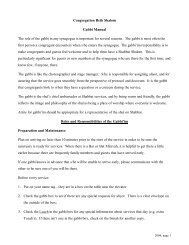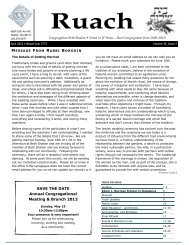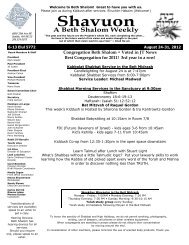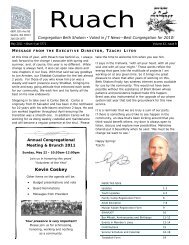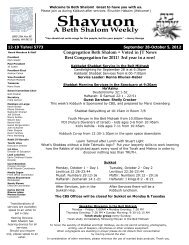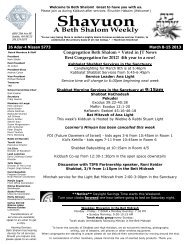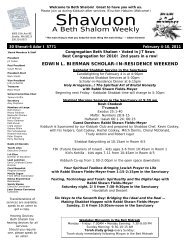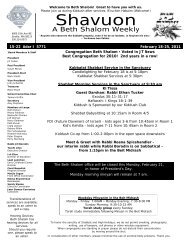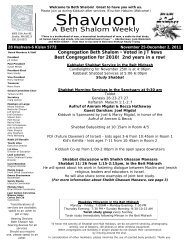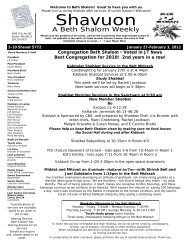Yom Kippur 5761 2010 Beth Huppin Yizkor - Congregation Beth ...
Yom Kippur 5761 2010 Beth Huppin Yizkor - Congregation Beth ...
Yom Kippur 5761 2010 Beth Huppin Yizkor - Congregation Beth ...
Create successful ePaper yourself
Turn your PDF publications into a flip-book with our unique Google optimized e-Paper software.
<strong>Yom</strong> <strong>Kippur</strong> <strong>5761</strong> <strong>2010</strong> <strong>Beth</strong> <strong>Huppin</strong> <strong>Yizkor</strong>I want to begin by thanking Rabbi Borodin for this opportunity to speak at <strong>Yizkor</strong> and for herwillingness to share the bimah during these days of awe. Rabbi, your generosity and your abilityto make space for others have truly enriched us. We are blessed to have you as our Rabbi andteacher.I also want to acknowledge and thank Rabbi Ira Stone. I am indebted to him for the ideasregarding soul creation and the world to come that I will be discussing. And I would like to thankmy parents and grandparents who taught me about the influence of a family table. Their positiveexample allowed me to make the connection between Rabbi Stone’s teaching and the texts that Iwill be sharing today.This year, as we approach <strong>Yizkor</strong>, my heart is heavier than usual. This summer marked the loss of3 dear friends – my beloved teacher and mentor, Joyce Shane, my dear childhood friend and peer,Mimi Arfin, and my cherished, former camper and student, Josh Isaac. They left us much too soonafter lengthy and difficult illnesses. Even as each carried a crushing physical burden, I watched inawe and I was deeply moved as they graciously and generously helped carry the burdens and joysof friends and loved ones.I know that many others here today had overwhelming losses this year. Though every year theintensity of <strong>Yizkor</strong> differs for each of us, we all face this moment with the memory of people wehave loved and miss deeply. Reflecting on their lives, we naturally wonder about our own life’spurpose. Rabbi Abraham Joshua Heschel wrote: “Life’s ultimate meaning remains obscure unlessit is reflected upon in the face of death.” (Moral Grandeur and Spiritual Audacity, pg 366)For me, connecting with other Jews throughout time and space who have reflected upon life’smeaning always brings me comfort, so in my own sorrow I sought guidance from Jewish texts.And as I studied, I stumbled upon a text I’d seen before, but hadn’t looked at closely. This time, itcalled out to me: “Darshaynee! Interpret me!” And it is this text that I want to share with younow.It is from the Kitzur Shulchan Aruch, a code of Jewish law written in the late 1800s in Hungary.“The generous people who had fed the poor at their table should be buried in a coffin made of theboards of that table, as it is said in Isaiah 58:8: : v’halach l’fanecha tzidkecha ‘And your tzedakahshall go before you.’” (kitzur shulchan aruch 199:1)This text led me to another related text in a Musar book called Kav HaYashar written over 100years earlier.<strong>Beth</strong> <strong>Huppin</strong>, <strong>Yom</strong> <strong>Kippur</strong> <strong>2010</strong>
“It has been the custom in some places for some people to be buried in coffins which were madefrom the tables upon which they studied, or upon which they fed the poor, or upon which theyworked faithfully at their trade.” (Kav HaYashar, chapter 46)Literally, I know what these texts mean; But when I read any text, I want to know what valuesinspired it. I’m certain these texts aren’t technical accounts about how to make a coffin. Rather,they ask me to consider what tables can teach us about the mysteries of both life and death.I’ve always thought a lot about tables and what they mean, perhaps because I inherited mygrandmother’s table. My grandfather always sat at the head of that table where he capably andefficiently ran the ritual aspects of the holiday meals. But, somehow, I think of it as mygrandmother’s table. Perhaps it is because the table always was overflowing with huge quantitiesof her lovingly prepared delicious food. Or perhaps it is because she refused to let us wash dishesafter meals since she thought we should use our time together to sit at the table and visit. Wecould have visited while doing dishes, but she wanted us all together ‐ at the table‐ for as long aspossible.Today, that same table sits in my house. I often tell my own guests that I remember sittingaround that table at holidays with all the extended family and, of course, it wasn’t a proper holidaywithout guests at the table ‐ young men serving in the military; students; members of thecommunity who didn’t have an extended family in Spokane who became part of our family for theholiday; and the handful of newcomers my father and uncle and grandfather sought out atservices that evening and brought home for the meal. There was always room for one more at myGrandmother’s table. And, if you went away hungry, as she would say, that was your own fault.But it wasn’t just food that was served. From my young eyes, at least, love was also served. AndAcceptance. And Community. And Safety. I was nourished in every way at that table. And whenmy grandparents died and their furniture was being distributed, I somehow inherited the table.I love that table because it represents the best of my grandparents’ values. Still, do I need theexact same table in my house in order to keep their values alive? What if my Grandmother hadbeen buried with her table?To answer these questions, I come back to the texts. I repeat the kitzur shulchan aruch text:“The generous people who had fed the poor at their table should be buried in a coffin made of theboards of that table, as it is said in Isaiah 58:8: v’halach l’fanecha tzidkecha ‘And your tzedakahshall go before you.’” The tzedakah, in this text represented by the table, will go before us,presumably into the next word. The way we treated others at the meal table will accompany usand define us for all eternity.The other text talks about 2 additional tables:<strong>Beth</strong> <strong>Huppin</strong>, <strong>Yom</strong> <strong>Kippur</strong> <strong>2010</strong>
“It has been the custom in some places for some people to be buried in coffins which were madefrom the tables upon which they studied, or upon which they fed the poor, or upon which theyworked faithfully at their trade. (Kav HaYashar, chapter 46)What do these 3 tables have in common? Very simply, I believe they represent our opportunitiesfor interactions with others. The table used to feed the poor indicates a meal of some kind. Andconversation. And companionship. Like my Grandmother’s table.The table used for study? Traditionally Jewish study is done in hevruta, meaning with a partner.There is no question that this form of study, with the right partner, is far more powerful thanstudying alone. Truly listening to someone and having that person truly listen to us forces us toclarify thoughts and to understand far more than would be possible alone. The French 20 thcentury philosopher, Emanual Levinas, refers to this potential deep connection as seeing the faceof another person. He suggests that when truly seeing another’s face, we actually obtain aglimpse of the Inifinite. And when our chevruta partner or any person who sits with us studying orsharing a meal or at any other time, becomes someone whose face we truly see, he or shebecomes our Teacher. Seeing the Divine spark in another person allows us to learn Torah in themost profound sense of the word. Rabbi Stone writes that when this happens: “As our teacher,our relationship with him or her is transformed such that it achieves the status of our relationshipwith God.”I believe the Rabbis understood this idea when it tells us that when Honi the Circlemaker awokeafter 70 years of sleep and realized his friends were all dead, , he cried out to God: “Oh hevruta,oh metuta,” “Give me my hevruta,– my study partner, my access to Your very presence, God – orgive me death.” God had mercy on him and allowed him to die.We have established, then, that both the table where we eat our meals and the table where westudy include other people, and therefore the potential to experience the Divine throughmeaningful relationship with others. What about the table where, as the text says, “the personworked faithfully at his trade.” Even if we work alone, our clients, our boss, or our co‐workers areimpacted by what happens at our work table. We can help carry their burdens and joys by ouractions, by our facial expressions, by our work ethic. I have never met a person whose work tabledoesn’t somehow present the opportunity to recognize God’s presence in others.So, why was there a tradition to be buried on the table upon which we fed the poor, studied orworked faithfully at our trade? Perhaps it is because those tables are the inanimate objects thatsee most intimately how we behave. Whether it is the study, meal or work table, the table is ametaphor for how we interact with others. And, if any of the inanimate objects that witness ourinteractions with others could speak, objects symbolized in this text by our table, what would theysay about us? If we were buried on our tables, would they go before us to God to bear witness tothe positive qualities of our souls?<strong>Beth</strong> <strong>Huppin</strong>, <strong>Yom</strong> <strong>Kippur</strong> <strong>2010</strong>
These texts require us to ask ourselves important questions: What happens when we sit at ourtables? Do we include others? If so, what do we talk about? Do we talk about other people? Or,do we talk about ideas? What is the tone that we set? Do we gossip? Complain? Whine?Accuse others?Or do we comfort? Study? Care for others? Do we articulate dreams? Alleviate pain? Sharemoments of joy?Do we recognize the image of God in the faces of the people who sit with us at our tables?Let’s go back to my grandmother’s table. I was blessed to have joyful table memories and Ilearned wonderful values at that table. But, I want to acknowledge that for some of us, thememories of family tables are painful. However, I want to suggest that we can also learn fromthose memories. Emotionally difficult table experiences can help us recognize in ourselves thepotential to inflict pain on others and can help us avoid repeating that behavior.I have no idea what my grandmother’s childhood table memories were, but I do know that she andmy grandfather had very difficult lives. Their childhoods were marked by losing parents andsiblings at young ages, leaving their homes as teenagers and coming to a new country where theirlives were not easy. When they met each other in Spokane, they had both already experiencedgreat losses. After they married, there were more losses, and they ended up raising 4 orphanedrelatives, as well as their own 3 children. They had very little money. They worked extremelyhard. When I was a child I never thought much about the fact that before I knew them their liveswere exceptionally difficult. To me, their home was filled with love. I realize now that they didn’tuse their pain to justify inflicting more pain on others. Instead, they generously opened theirhome and their table.Unfortunately, we know that today there are more and more homes where regular tablegatherings are rare. Everyone is too busy.And if we don’t have time for gathering around the table for meals, for study or for meaningfulwork with others, memories of gatherings around tables with people now dead are not enough tosustain us and create new memories into the future. Perhaps that is one reason why people wereburied with their tables.We remember loved ones and sometimes we think the values we saw at their tables define us –forgood or for bad. But it is what we do with what they taught us that defines us. My grandmother’stable, but itself, cannot welcome people. I may own her table, but the merit of her generosity isher merit, not mine. And if I came from a family that didn’t care for others, I would still able tomake the choice to live my life differently. I can learn from that which I don’t want to emulate aswell as from that which I do want to emulate. Either way, I still have to make a choice about how Iam going to act. As Rabbi Stone has written, no moment is neutral. Every moment represents achoice.<strong>Beth</strong> <strong>Huppin</strong>, <strong>Yom</strong> <strong>Kippur</strong> <strong>2010</strong>
Today, as <strong>Yizkor</strong> approaches, we reflect on the choices made by loved ones and choices we stillhave the power to make. We are reminded that there is a limited amount of time in which tomake those choices. Our body won’t last forever. It is given to us at birth and we aren’t given achoice about what it will look like or what its physical needs will be. Our body is a vessel whichneeds to be fed and cleaned. It is finite. It can get sick. Ultimately, it will die. But our soul isinfinite. And what is it about our soul that makes it infinite? Rabbi Stone argues that while Godbreathes a soul into each of us, that soul is still ours to develop, to expand, to, as it were, create.How do we create our souls? Here is where I believe that the table is crucial.When we sit with someone at a table, to eat, to study or to work we have the potential, as Idiscussed earlier, to really see the face of another person. Franz Rosenzweig, a 20 th centuryGerman Jewish philosopher and colleague of Martin Buber, wrote in his book, The Star ofRedemption, of the encounter with another person (pg 257) and reflects on the commandment,you shall love your neighbor as or “like” yourself ‐ kamocha:“…out of the infinite chaos of the world, a neighbor, his neighbor, is placed before his soul, and ofhim, to begin with exclusively of him, he is told: he is like you. ‘Like you,’ hence, not ‘you.’ Youremain You and you will remain You. But he will not remain a He for you and hence only a This foryour You; no, he is like you, like your You, a You like you, an I,‐ a soul.”Rabbi Stone also writes about the soul when describing our potential relationships with others.Building on Levinas’ idea of seeing the face of the other, Rabbi Stone suggests that when we trulysee the image of God in the other, when we are able to help carry his or her burden and escapeour own natural tendency towards self‐absorption, that is when our own soul is created. Our soulis ours to create – but it can’t be created alone. To do that, we need to truly experience and carefor another soul.Rabbi Stone suggests that this is the moment of olam habah – the world to come ‐ a taste ofeternity because this is the moment that our soul is created and, unlike our body, our soul iseternal. That eternity of our soul is what we mean when we say Olam Haba – the world to come.Each time we truly make space for another human being – our soul – our infinite self – expands.Each moment that we sit at the table with another we have the potential to escape our selfabsorptionand enlarge our soul. As a result, the table is the concrete witness, not only to ourdeeds, but also to the creation of our soul.Once we die, we can no longer sit at any table. We can no longer provide meals for those who arehungry. We can no longer show up at a shiva house or count in a minyan. Our hands can nolonger knock on the door of a friend who is sad and we can no longer bring consolation or do actsof kindness. Those opportunities to create our soul by carrying the pain or joy of another existonly while we have bodies. In the next world, where we are purely soul, our soul lives into eternityreunited with the souls we helped create when we were present for them – including the peoplewe loved and who loved us. Because we intersect meaningfully with others in the process ofcreating our own souls, we have the potential to help create and develop their souls as well. And<strong>Beth</strong> <strong>Huppin</strong>, <strong>Yom</strong> <strong>Kippur</strong> <strong>2010</strong>
they, as a result of developing their own souls, potentially are moved to recognize God’s presencein others. This chain of soul creation and expansion can be infinite. Indirectly, we play a part in theability and opportunity of those we have cared for to interact positively with others we may nevermeet. And as a result, we are connected to those souls as well. And since this intersectionhappens infinitely throughout time – back in generations until the beginning of time, as well asforward until the end of time, then by expanding our own souls each time we make space foranother, we are also connecting with people we will never know, infinitely, through the present,into both the past and the future. And this is infinity. This is olam habah.We don’t know what happens after we die. But I believe that our souls spend eternity living withthe results of the space we make for others while we are alive. This may be literal or it may bemetaphorical – but it doesn’t matter because either way, the kindnesses we extend to others domatter. This is why the text says our table goes before us into the next world. Our table willvouch for the creation and quality of our souls. I have no doubt that the symbolic tables of myfriends Joyce, Mimi and Josh have spoken well of their beautiful souls. They made space for manypeople, including me and for that I will be forever grateful. I am comforted by the belief thatthough their bodies are gone, their souls and mine are now bound for eternity.I want to end by going back to the beginning. At that time I acknowledged Rabbi Stone, myparents and my grandparents for providing inspiration for this D’var Torah. As I conclude I alsowant to thank those who inspired and taught them. These are people I never met, but withoutwhom, Rabbi Stone, my parents and grandparents could not have taught me. And, in truth, I mustalso thank those who inspired the people who inspired them, and so on and so forth back to thebeginning of time, because we must acknowledge that none of us came into this world on our ownand none of us became who we are on our own. Each of us is indebted to many more people thanwe can ever know. In fact, the debt is infinite. As we remember our loved ones, we should alsoremember that there were people they remembered ‐ people we didn’t know. And so that debt ofmemory and gratefulness and soul creation goes back in time, just as we will be remembered andthose who remember us will, in turn be remembered, and connected to our souls forward intotime. As <strong>Yizkor</strong> begins, let us reflect upon the choices we can make to expand our own souls at ourown tables, for this expansion of our souls is our gateway to olam habah. Perhaps our tablesprovide the opportunity to connect and reconnect eternally with both past and future generationsof our loved ones.G’mar hatimah Tovah<strong>Beth</strong> <strong>Huppin</strong>, <strong>Yom</strong> <strong>Kippur</strong> <strong>2010</strong>



